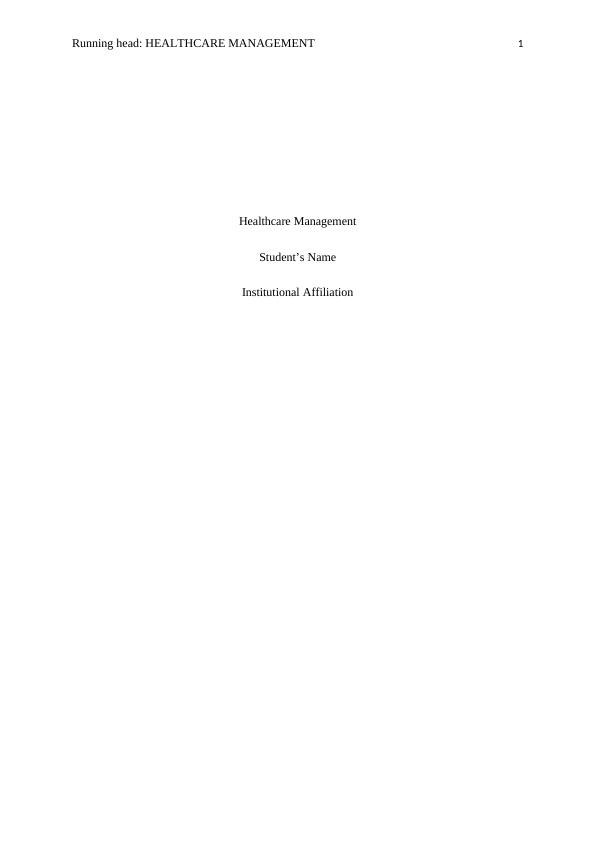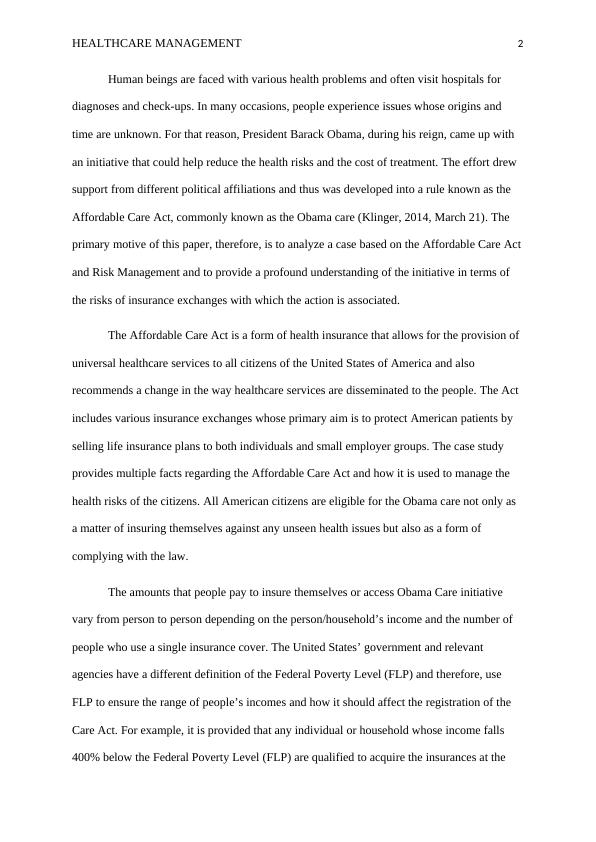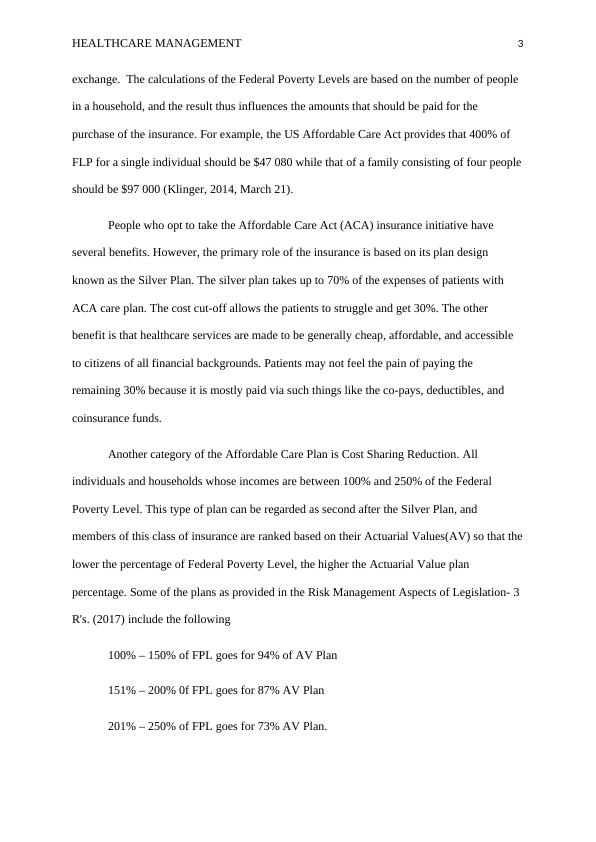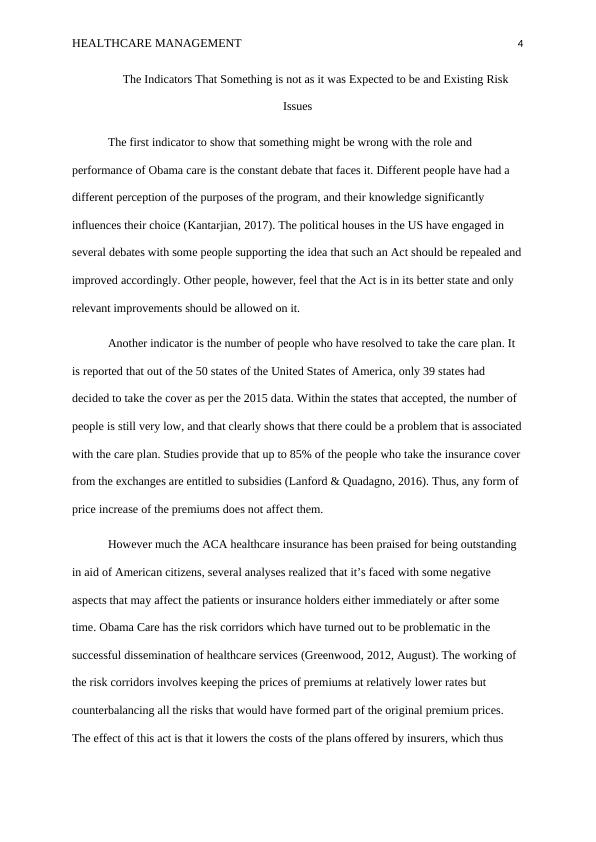Analyzing the Affordable Care Act and Risk Management
12 Pages3025 Words143 Views
Added on 2023-03-31
About This Document
This paper analyzes the Affordable Care Act and Risk Management, providing a profound understanding of the initiative in terms of the risks of insurance exchanges.
Analyzing the Affordable Care Act and Risk Management
Added on 2023-03-31
ShareRelated Documents
Running head: HEALTHCARE MANAGEMENT 1
Healthcare Management
Student’s Name
Institutional Affiliation
Healthcare Management
Student’s Name
Institutional Affiliation

HEALTHCARE MANAGEMENT 2
Human beings are faced with various health problems and often visit hospitals for
diagnoses and check-ups. In many occasions, people experience issues whose origins and
time are unknown. For that reason, President Barack Obama, during his reign, came up with
an initiative that could help reduce the health risks and the cost of treatment. The effort drew
support from different political affiliations and thus was developed into a rule known as the
Affordable Care Act, commonly known as the Obama care (Klinger, 2014, March 21). The
primary motive of this paper, therefore, is to analyze a case based on the Affordable Care Act
and Risk Management and to provide a profound understanding of the initiative in terms of
the risks of insurance exchanges with which the action is associated.
The Affordable Care Act is a form of health insurance that allows for the provision of
universal healthcare services to all citizens of the United States of America and also
recommends a change in the way healthcare services are disseminated to the people. The Act
includes various insurance exchanges whose primary aim is to protect American patients by
selling life insurance plans to both individuals and small employer groups. The case study
provides multiple facts regarding the Affordable Care Act and how it is used to manage the
health risks of the citizens. All American citizens are eligible for the Obama care not only as
a matter of insuring themselves against any unseen health issues but also as a form of
complying with the law.
The amounts that people pay to insure themselves or access Obama Care initiative
vary from person to person depending on the person/household’s income and the number of
people who use a single insurance cover. The United States’ government and relevant
agencies have a different definition of the Federal Poverty Level (FLP) and therefore, use
FLP to ensure the range of people’s incomes and how it should affect the registration of the
Care Act. For example, it is provided that any individual or household whose income falls
400% below the Federal Poverty Level (FLP) are qualified to acquire the insurances at the
Human beings are faced with various health problems and often visit hospitals for
diagnoses and check-ups. In many occasions, people experience issues whose origins and
time are unknown. For that reason, President Barack Obama, during his reign, came up with
an initiative that could help reduce the health risks and the cost of treatment. The effort drew
support from different political affiliations and thus was developed into a rule known as the
Affordable Care Act, commonly known as the Obama care (Klinger, 2014, March 21). The
primary motive of this paper, therefore, is to analyze a case based on the Affordable Care Act
and Risk Management and to provide a profound understanding of the initiative in terms of
the risks of insurance exchanges with which the action is associated.
The Affordable Care Act is a form of health insurance that allows for the provision of
universal healthcare services to all citizens of the United States of America and also
recommends a change in the way healthcare services are disseminated to the people. The Act
includes various insurance exchanges whose primary aim is to protect American patients by
selling life insurance plans to both individuals and small employer groups. The case study
provides multiple facts regarding the Affordable Care Act and how it is used to manage the
health risks of the citizens. All American citizens are eligible for the Obama care not only as
a matter of insuring themselves against any unseen health issues but also as a form of
complying with the law.
The amounts that people pay to insure themselves or access Obama Care initiative
vary from person to person depending on the person/household’s income and the number of
people who use a single insurance cover. The United States’ government and relevant
agencies have a different definition of the Federal Poverty Level (FLP) and therefore, use
FLP to ensure the range of people’s incomes and how it should affect the registration of the
Care Act. For example, it is provided that any individual or household whose income falls
400% below the Federal Poverty Level (FLP) are qualified to acquire the insurances at the

HEALTHCARE MANAGEMENT 3
exchange. The calculations of the Federal Poverty Levels are based on the number of people
in a household, and the result thus influences the amounts that should be paid for the
purchase of the insurance. For example, the US Affordable Care Act provides that 400% of
FLP for a single individual should be $47 080 while that of a family consisting of four people
should be $97 000 (Klinger, 2014, March 21).
People who opt to take the Affordable Care Act (ACA) insurance initiative have
several benefits. However, the primary role of the insurance is based on its plan design
known as the Silver Plan. The silver plan takes up to 70% of the expenses of patients with
ACA care plan. The cost cut-off allows the patients to struggle and get 30%. The other
benefit is that healthcare services are made to be generally cheap, affordable, and accessible
to citizens of all financial backgrounds. Patients may not feel the pain of paying the
remaining 30% because it is mostly paid via such things like the co-pays, deductibles, and
coinsurance funds.
Another category of the Affordable Care Plan is Cost Sharing Reduction. All
individuals and households whose incomes are between 100% and 250% of the Federal
Poverty Level. This type of plan can be regarded as second after the Silver Plan, and
members of this class of insurance are ranked based on their Actuarial Values(AV) so that the
lower the percentage of Federal Poverty Level, the higher the Actuarial Value plan
percentage. Some of the plans as provided in the Risk Management Aspects of Legislation- 3
R's. (2017) include the following
100% – 150% of FPL goes for 94% of AV Plan
151% – 200% 0f FPL goes for 87% AV Plan
201% – 250% of FPL goes for 73% AV Plan.
exchange. The calculations of the Federal Poverty Levels are based on the number of people
in a household, and the result thus influences the amounts that should be paid for the
purchase of the insurance. For example, the US Affordable Care Act provides that 400% of
FLP for a single individual should be $47 080 while that of a family consisting of four people
should be $97 000 (Klinger, 2014, March 21).
People who opt to take the Affordable Care Act (ACA) insurance initiative have
several benefits. However, the primary role of the insurance is based on its plan design
known as the Silver Plan. The silver plan takes up to 70% of the expenses of patients with
ACA care plan. The cost cut-off allows the patients to struggle and get 30%. The other
benefit is that healthcare services are made to be generally cheap, affordable, and accessible
to citizens of all financial backgrounds. Patients may not feel the pain of paying the
remaining 30% because it is mostly paid via such things like the co-pays, deductibles, and
coinsurance funds.
Another category of the Affordable Care Plan is Cost Sharing Reduction. All
individuals and households whose incomes are between 100% and 250% of the Federal
Poverty Level. This type of plan can be regarded as second after the Silver Plan, and
members of this class of insurance are ranked based on their Actuarial Values(AV) so that the
lower the percentage of Federal Poverty Level, the higher the Actuarial Value plan
percentage. Some of the plans as provided in the Risk Management Aspects of Legislation- 3
R's. (2017) include the following
100% – 150% of FPL goes for 94% of AV Plan
151% – 200% 0f FPL goes for 87% AV Plan
201% – 250% of FPL goes for 73% AV Plan.

HEALTHCARE MANAGEMENT 4
The Indicators That Something is not as it was Expected to be and Existing Risk
Issues
The first indicator to show that something might be wrong with the role and
performance of Obama care is the constant debate that faces it. Different people have had a
different perception of the purposes of the program, and their knowledge significantly
influences their choice (Kantarjian, 2017). The political houses in the US have engaged in
several debates with some people supporting the idea that such an Act should be repealed and
improved accordingly. Other people, however, feel that the Act is in its better state and only
relevant improvements should be allowed on it.
Another indicator is the number of people who have resolved to take the care plan. It
is reported that out of the 50 states of the United States of America, only 39 states had
decided to take the cover as per the 2015 data. Within the states that accepted, the number of
people is still very low, and that clearly shows that there could be a problem that is associated
with the care plan. Studies provide that up to 85% of the people who take the insurance cover
from the exchanges are entitled to subsidies (Lanford & Quadagno, 2016). Thus, any form of
price increase of the premiums does not affect them.
However much the ACA healthcare insurance has been praised for being outstanding
in aid of American citizens, several analyses realized that it’s faced with some negative
aspects that may affect the patients or insurance holders either immediately or after some
time. Obama Care has the risk corridors which have turned out to be problematic in the
successful dissemination of healthcare services (Greenwood, 2012, August). The working of
the risk corridors involves keeping the prices of premiums at relatively lower rates but
counterbalancing all the risks that would have formed part of the original premium prices.
The effect of this act is that it lowers the costs of the plans offered by insurers, which thus
The Indicators That Something is not as it was Expected to be and Existing Risk
Issues
The first indicator to show that something might be wrong with the role and
performance of Obama care is the constant debate that faces it. Different people have had a
different perception of the purposes of the program, and their knowledge significantly
influences their choice (Kantarjian, 2017). The political houses in the US have engaged in
several debates with some people supporting the idea that such an Act should be repealed and
improved accordingly. Other people, however, feel that the Act is in its better state and only
relevant improvements should be allowed on it.
Another indicator is the number of people who have resolved to take the care plan. It
is reported that out of the 50 states of the United States of America, only 39 states had
decided to take the cover as per the 2015 data. Within the states that accepted, the number of
people is still very low, and that clearly shows that there could be a problem that is associated
with the care plan. Studies provide that up to 85% of the people who take the insurance cover
from the exchanges are entitled to subsidies (Lanford & Quadagno, 2016). Thus, any form of
price increase of the premiums does not affect them.
However much the ACA healthcare insurance has been praised for being outstanding
in aid of American citizens, several analyses realized that it’s faced with some negative
aspects that may affect the patients or insurance holders either immediately or after some
time. Obama Care has the risk corridors which have turned out to be problematic in the
successful dissemination of healthcare services (Greenwood, 2012, August). The working of
the risk corridors involves keeping the prices of premiums at relatively lower rates but
counterbalancing all the risks that would have formed part of the original premium prices.
The effect of this act is that it lowers the costs of the plans offered by insurers, which thus

End of preview
Want to access all the pages? Upload your documents or become a member.
Related Documents
Importance of Health Insurance: Benefits, Impacts, and Penaltieslg...
|4
|2372
|73
Patient Protection and the Affordable Care Actlg...
|8
|1601
|322
Report The Issue of the Affordable Care Actlg...
|8
|1767
|170
Economics of the Affordable Care Act (ACA) from 2011-2014lg...
|9
|2081
|308
The Role of Government in the U.S. Health Care Systemlg...
|6
|1512
|494
Evaluation of Affordable Care Act | Assignmentlg...
|4
|688
|17
